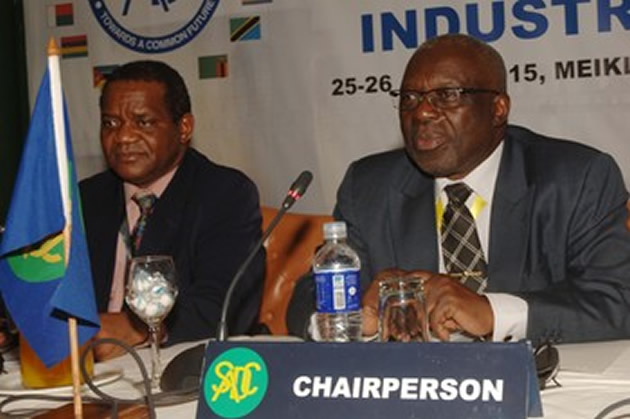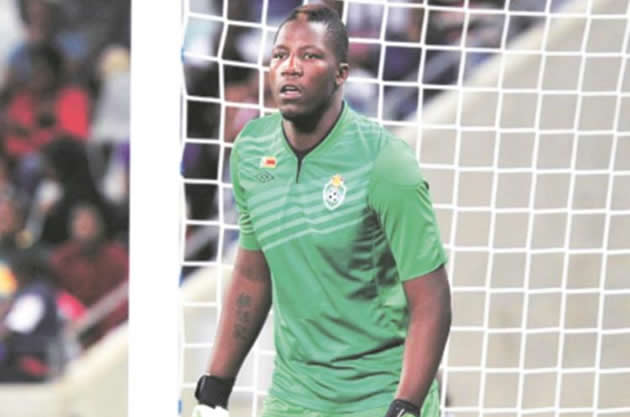Sadc and the politics of regional integration


SADC Chairperson of the Standing committee of senior officials Ambassador Joey Bimha (right) addresses a meeting while flanked by Deputy Executive Secretary-Regional Integration Dr Thembinkosi Mhlongo in Harare on Monday
Tichaona Zindoga Political Editor
Harare is this week the centre of regional focus — bar the disquiet over the xenophobic violence in South Africa — as leaders and diplomats take part in the Sadc Extraordinary Summit on Regional Strategy and Roadmap for Industrialisation.
The theme revolves around the long-held need for regional co-operation and the relatively newer concepts of industrialisation and beneficiation/value addition that President Mugabe, the current chairperson, has been selling at home, regionally and continentally.
While it is expected that the region is going to adopt a number of well-meaning plans and strategies, it remains to be seen whether these blueprints will be adopted, indeed, see the materialisation of a mini-European Union (touted as an exemplary bloc) of Africa.
So, what is the politics of Sadc regional integration and what are the likely factors to aid or militate against the consummation of the Southern African dream?
Historically, Sadc was born out the political struggles of the region, firstly as Frontline States and secondly as the Southern African Development Co-ordination Conference (Sadcc) which sought to create an economic buffer against apartheid South Africa, which was a destabilising force both economically and politically.
The independence of South Africa and its entry into the global family of nations came with its own challenges, and opportunities.
First, is the challenge that South Africa has been viewed as a continuation of apartheid to the extent of its economic hegemony as a bequest of apartheid’s infrastructure.
On the superstructure level, there have been concerns that South Africa has tried to play big brother hence its military ambitions in the region, ranging from Lesotho to the Democratic Republic of Congo, although it may not have entirely succeeded.
But that could be regarded, in lighter terms, as sibling rivalry.
Take for example Judith Makwanya, a ZBC correspondent’s loquacious question to President Mugabe on the occasion of his State visit to South Africa recently.
Makwanya sought to know, essentially, what the two countries thought of the skewed nature of economic relations between them.
President Mugabe was diplomatic and pragmatic about the question, noting that South Africa’s economy was far bigger than that of Zimbabwe and there could not be parity among the two.
President Mugabe does not seem to harbour any petty sibling rivalry.
He rather challenged South Africa to show leadership in the region, saying: “We also appeal to South Africa which is highly industrialised to lead us in this and work with us, and cooperate with us and not just regard the whole continent as an open market for products from South Africa.”
The agenda of the current Extraordinary Summit was set in Victoria Falls.
A model body
While writing for the influential think-tank Council on Foreign Relations, Fraser Cameron, Senior Adviser, European Policy Centre, Adjunct Professor, Hertie School of Governance, Berlin makes a strong case for the adoption of the European Union as the model of regional integration.
This is Southern Africa, of course, but then there are salient points to be made, similarities to be drawn.
One inescapable point he makes is that, “Compared to most other regions of the world, the EU is a haven of peace, prosperity, and security.”
Sadc is also Africa’s most peaceful and secure and fairly prosperous region.
Cameron makes a case for regional integration assuming that regionalism is a building bloc of globalization to the extent that, “EU member states acting alone will be unable to achieve the results that could be gained through a 500-million-strong bloc.”
Sadc has about 250 million people, and the case for such integration has even been made by people like Professor Arthur Mutambara.
Cameron notes that the EU has been a pioneer in regional integration since the early 1950s.
Factors underpinning the success of the EU include, according to the paper, “visionary politicians . . . who conceived of a new form of politics based on the supranational ‘community method’ rather than the traditional balance-of-power model’; ‘the political will to share sovereignty and construct strong, legally based, common institutions to oversee the integration project’; ‘a consensus approach combined with solidarity and tolerance’ and ‘historical reconciliation’”.
These factors are very similar to Sadc, not least the visionary leadership and political will: if they are not historical, they are achievable.
It remains to be seen whether Sadc will take the next step forward.
After all, according to Cameron, “There have been innumerable declarations from groupings in Asia, Africa, the Middle East, and South and Central America about the desirability of closer cooperation and even integration, but the record shows that the rhetoric has not been matched by action.”
That is a challenge to the leaders.
Cameron counsels that while not always politically expedient, national governments would be wise to put the long-term goal of cooperation above more immediate domestic priorities.
“More importantly,” he says, “if integration is to succeed, governments and publics should believe that it is in their vital national interest. Without such commitment, regional groupings will crumble at the first bump in the long road to integration.”
South Africa’s burden
We noted above President Mugabe challenging South Africa, which is the most industrialised nation in the region, to lead and help the rest of the pack.
Mills Soko, writing a paper titled “The Political Economy of Regional Integration in Southern Africa” recognizes this as South Africa’s “burden of regional leadership”.
Argues Soko: “In sum, regional integration in Southern Africa will not succeed unless South Africa, by far the biggest and most diversified economy in the region, discharges its responsibilities in accordance with its hegemonic status.
“Whether South Africa can assume a hegemonic regional role will depend on three considerations: first, the extent to which the country’s political and bureaucratic elites are able to balance the country’s regional obligations against domestic pressures; second, the manner in which the country deals with the legacy of apartheid South Africa’s historical destabilisation of the region; and third, the degree to which the country’s leadership credentials are accepted by other regional states.”
South Africa’s responsibility to lead is made keener by the fact that as the leading economy, it has become the destination of economic refugees, which could constitute a cause for the recent flare up of xenophobia.
If regional economies grow uniformly, the problem — South Africa’s problem — of immigration and its attendant challenges such as undue pressure on South Africa’s resources, are avoidable.
Economic equity will also foster political cooperation among member states and reduce resentment and petty hates among leaders and citizens of these countries.
Harare should be historical.
And the region is looking on.









Comments